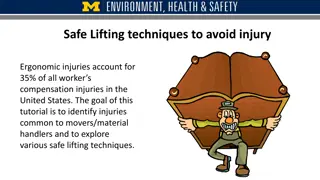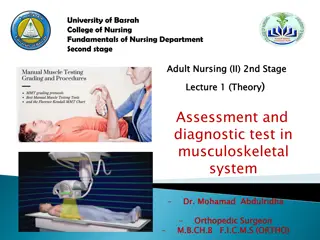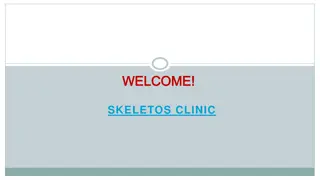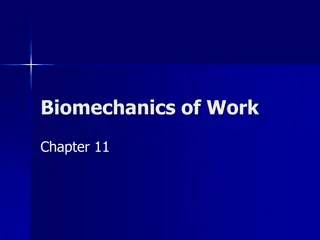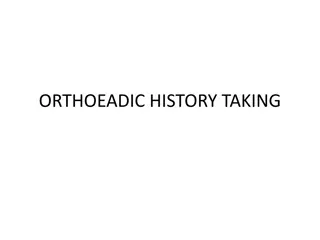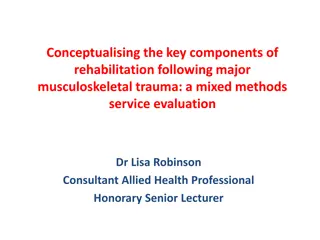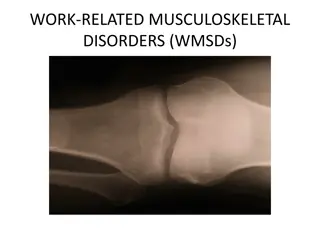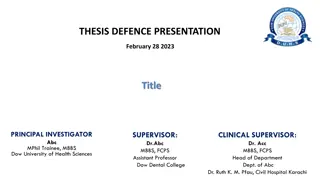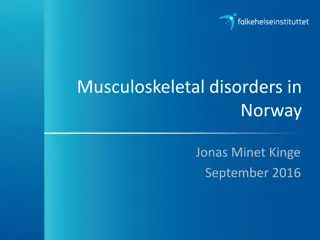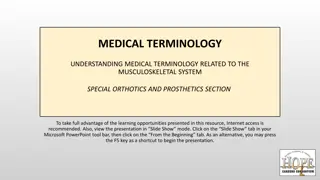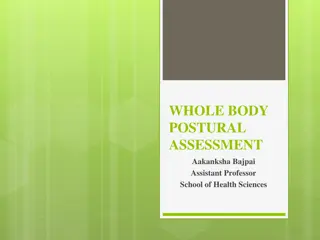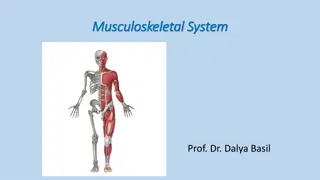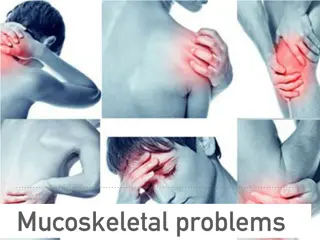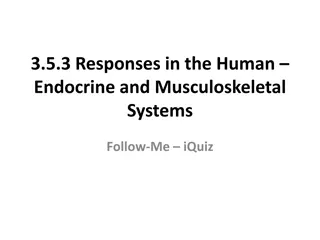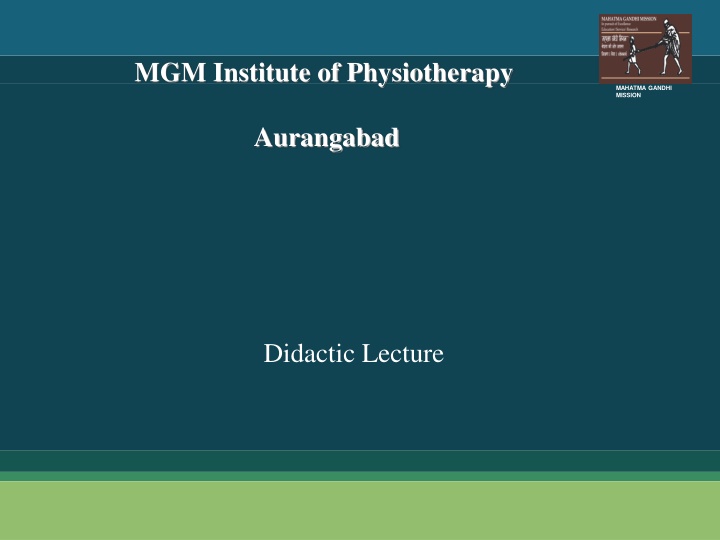
Musculoskeletal Assessment: Understanding Principles and Examination Procedures
Learn about musculoskeletal assessment principles and examination procedures in this didactic lecture. Topics include subjective assessment cues, hypothesis formulation, inspection, palpation, sensory examination, range of motion, and special tests. Enhance your skills in identifying musculoskeletal issues and performing a comprehensive assessment.
Download Presentation

Please find below an Image/Link to download the presentation.
The content on the website is provided AS IS for your information and personal use only. It may not be sold, licensed, or shared on other websites without obtaining consent from the author. If you encounter any issues during the download, it is possible that the publisher has removed the file from their server.
You are allowed to download the files provided on this website for personal or commercial use, subject to the condition that they are used lawfully. All files are the property of their respective owners.
The content on the website is provided AS IS for your information and personal use only. It may not be sold, licensed, or shared on other websites without obtaining consent from the author.
E N D
Presentation Transcript
MGM Institute of Physiotherapy MAHATMA GANDHI MISSION Aurangabad Didactic Lecture
Company LOGO Introduction to Musculoskeletal/ Orthopedic Assessment Dr. surendra Wani Dept. Of Musculoskeletal Physiotherapy MGM Institute Of Physiotherapy Chh. Sambhajinagar www.company.com www.company.com
Learning Objectives At the end of the lecture, the student should be able to: Determine the principles and concepts of a musculoskeletal assessment Identify cues and information that needs to be obtained in a subjective musculoskeletal assessment Formulate hypothesis of the problems assessed and determine examination procedures that may confirm or refute a hypothesis SKW 3
OBJECTIVE ASSESSMENT Inspection Palpation Sensory examination Range of Motion Joint play Muscle Performance/Motor control/resisted iso. Dermatomes,myoto mes Posture, Gait, locomotion, and balance Special Tests Anthropometric measurements Functional assessment Environmental assessment SKW 4
OCULAR INSPECTION Manner of arrival Ambulatory: independent or with device or dependent on caregiver for mobility Facial expression: apprehensive, restless, depressed, in discomfort Body type Ectomorph, endomorph, mesomorph Level of consciousness Attachments: cast, fixation devices, dressings Swelling Trophic skin changes Atrophy Gross deformities SKW 5
Observation Posture Deformity (structural or dynamic): restricted ROM, malalignment, bone shape alteration or joint deformity Bony contours normal and symmetric Soft tissue contours normal and symmetric Color and texture of the skin Any scars, signs of inflammation Patient s facial expression and comfort SKW 6
Skin conditions Implications Loss of skin elasticity, shiny, hair loss, breakdown and healing, nails brittle and hard Peripheral nerve lesions cyanosis Poor blood perfusion Redness Inflammation SKW 7
Examination principles Normal side assessed first Active movements before passive and then RIMs Myotonal weakness takes time to develop, so sustain contraction for at least 5secs Movements that are painful done last Passive ROM: degree and quality both imp RIMs: done in Mid range, to differentiate contractile vs noncontractile tissues. Joint end feel: do not exacerbate symptoms Ligamentous tests: stress applied gently and several times and increased stress but not beyond the point of pain. Thus, maximum instability demonstrated with no muscle spasm Note for vascular insufficiencies Relax the patient SKW 8
PALPATION The therapist should take note of the following: Tenderness Swelling Variations in temperature Muscle spasm Differences in tissue texture Abnormal sensation Grading of tenderness Grade I: pt complains of pain Grade II: pt complains of pain and winces Grade III: pt winces and withdraws the part Grade IV: pt does not allow palpation Swelling Bony/hard: osteophyte formation Boggy, spongy: synovial Soft, pliable, fluctuating: fluid Hard, thick, gel-like, warm: blood Thick, non-fluctuating, warm:pus Tough, dry, leathery:callus Thick, slow moving, indentation after pressure: pitting edema Abnormal Sensation Dysesthesia: diminished sensation Hyperesthesia: increased sensation Anesthesia: absence of sensation Crepitus: grating, creaking upon movement of a limb usually in the joint or tendinous unit SKW 9
Scar Adherent / Non Adherent SKW 10
Deep Tendon (Stretch) Reflexes Comparison of both sides is very important. A patient may present with symmetrically decreased reflexes and be perfectly normal Hyperreflexia - upper motor neuron disease secondary to decreased inhibition by the motor cortex Hyporeflexia - lower motor neuron disease may be the causative factor secondary to an interruption n the reflex arc 0: absent reflex 1+: trace, or seen only with reinforcement 2+: normal 3+: brisk 4+: nonsustained clonus (i.e., repetitive vibratory movements) 5+: sustained clonus SKW 11
RANGE OF MOTION ASSESSMENT Observe / palpate the movement of the other joints Ask the patient to perform the painful movement as a baseline for your assessment Watch out for trick movements Check the end-feel SKW 12
Range of Motion: Active ROM The therapist should note the following: When and where during the movement onset of pain occurs Whether the movement painful/painless Patient reaction Amount of restriction Pattern of movement Quality of movement Movement of associated joints Willingness of the patient to move the segment SKW 13
Range of Motion: Passive ROM The therapist should note the following: When and where during movement the pain begins Whether the movement increases the intensity and quality of pain Pattern of limitation of movement Capsular or non-capsular End feel of movement Movement of associated joints Range of motion available SKW 14
End feels Normal Bone to Bone Soft Tissue Approximation - Tissue Stretch Abnormal Early Muscle Spasm Late Muscle Spasm Hard Capsular - Soft Capsular Bone to Bone - Empty - Springy Block SKW 15
CAPSULAR PATTERN Seen when entire capsule is shortened Manifests itself as a characteristic pattern of decreased ROM at a joint Follows the sequence of descending decreased ROM E.g - shoulder- ER, abduction, IR SKW 16
Assessment of joint play Moving the articular surfaces Direction of movement during assessment is either PARALLEL or PERPENDICULAR to the treatment plane Distraction joint play assessment Gliding joint play assessment SKW 17
SKW 18
The therapist should take into consideration the following: Patient should be relaxed and fully supported Use firm and comfortable grasp Examine one joint and movement at a time Test the unaffected side first As one surface is moved, the other is stabilized Movements should not be forced Movements should not cause discomfort Loose packed position SKW 19
SKW 20
MUSCLE PERFORMANCE The therapist should assess various components of muscle performance (if appropriate): Strength Muscular endurance Power Use of manual muscle test (MMT,fitness testing tools to determine baseline function of individual muscles or groups of muscles SKW 21
Grades Normal (5): The muscle can withstand a strong degree of resistance against gravity. Good (4): The muscle can withstand a moderate degree of resistance against gravity. Fair (3): The muscle is able to sustain the test position against gravity. Poor (2): The muscle is able to complete the range of motion in a plane that is parallel to gravity (gravity eliminated). Trace (1): The muscle can perform a palpable contraction but without any visible movement. Zero (0): No contraction is present SKW 22
Resisted Movement Testing Resisted movement testing involves an isometric contraction of the muscle that is performed in the neutral (mid) position. The joint must be held still so that the amount of stress placed on the inert (noncontractile) structures is minimized Resisted testing will help isolate the musculotendinous unit as the cause of the pain. SKW 23
1. Strong and painful -an injury to some part of the muscle or tendon. 2. Weak and painless -a full rupture of the muscle or may imply an interruption of the nervous innervation of the muscle. 3. Weak and painful - gross lesion such as a fracture or metastatic lesion. 4. Strong and painless responses are indicative of normal structures. SKW 24
POSTURE Provides information as to the probable cause of the deformity The therapist should note the following: Difference in alignment of the body segments: asymmetry Presence of upper/lower crossed syndromes Guidelines: Patient appropriately undressed No shoes, socks, stockings Note use of walking aids, braces, etc. Examine in the habitual, relaxed posture Assess in standing, sitting, and lying positions Weak lengthened phasic muscles Tight hypertonic postural muscle JOINT Tight hypertonic postural muscle Weak lengthened phasic muscles SKW 25
SKW 26
SKW 27
SKW 28
SKW 29
SKW 30
SPECIAL TESTS Allows the therapist to: Confirm a tentative diagnosis Make a differential diagnosis Differentiate between structures Understand unusual signs Unravel difficult signs and symptoms Some tests have poor reliability and validity therefore the therapist should use these with caution Findings depend on the skill and ability of the examiner to perform and identify (+) and (-) signs SKW 31
ANTHROPOMETRIC MEASUREMENTS Helps in formulation of a diagnosis/impression regarding the patient s condition (leg length discrepancy), in prognosis (swelling), and in identifying the patient s body type (skinfold measurement) Performed in the presence of: Swelling Asymmetry in limb girth Postural and gait deviations Amputation SKW 32
GAIT, LOCOMOTION ASSESSMENT Majority of gait assessment is observation The therapist should take note of the following: Presence of gait deviations: abnormal gait patterns Difference between the right and left lower extremity during specific cycles/phases of gait Compensatory mechanisms Speed and cadence of walking Guidelines: The patient should be assessed both in normal footwear and in bare feet Take time to observe the patient during gait assessment Assess in the anterior, posterior and lateral views Note use of gait aids, etc. SKW 33
FUNCTIONAL ASSESSMENT Uses of functional assessment: Helps the therapist establish what is important to the patient and the patient s expectations Represents a measurement of a whole-body task performance ability Determines the effect of injury to the patient s daily functions/activities May involve task analysis, use of various functional assessment tools, fitness profiles SKW 34
ENVIRONMENTAL ASSESSMENT Home or workplace assessment provides the therapist information regarding the influence of the patient s environment to the present condition Are there any barriers to normal movement that predispose the patient to certain conditions? Are modifications necessary to allow proper performance of activities? SKW 35
NEUROLOGIC ASSESSMENT Performed in certain conditions that involve neurologic structures Nerve lesions: peripheral nerve injuries Provides baseline information regarding the integrity of the patient s neural structures The therapist assesses the following: Sensation Deep tendon reflexes SKW 36
Summary & Questions End feels and its types Capsular and non capsular pattern. Joint mobility assessment Joint play SKW 37
QUESTIONS??? Company LOGO THANK YOU THANK YOU FOR FOR LISTENING! LISTENING! www.company.com www.company.com
REFERENCES Hertling, D. and Kessler, R. (1990). Management of common musculoskeletal disorders: Physical therapy principles and methods (2nd ed.). San Francisco: J. B. Lippincott Company. Loudon, J., Bell, S., and Johnstin, J. (1998). The clinical orthopedic assessment guide. USA: Human Kinetics. Magee, D. (2002). Orthopedic physical assessment (4th ed.). Singapore: Elsevier Sciences. Refshauge, K. and Gass, E. (1995). Musculoskeletal physiotherapy: Clinical science and practice. London: Butterworth-Heinemann Ltd. Starkey, C. and Ryan, J. (1996). Evaluation of orthopedic and athletic injuries. USA: F. A. Davis Company. SKW 39


